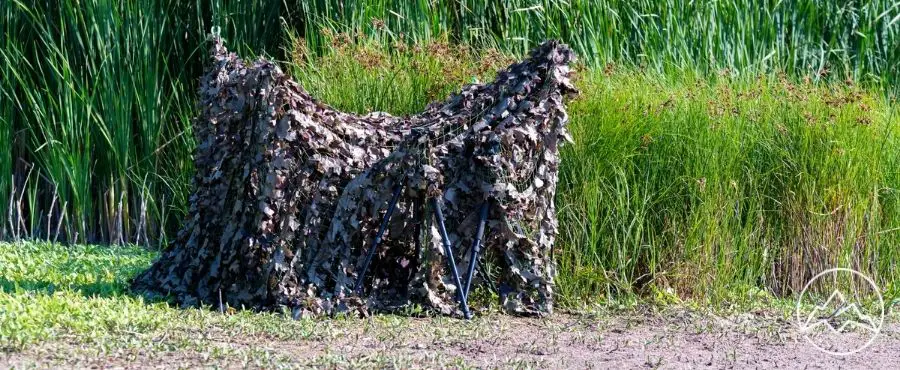Choosing a blind location in a feeding area or a travel corridor can skyrocket your chances of success. Still, you’re also going to want to blend into your surroundings and consider environmental factors such as the wind. Let’s take a look at six essential things to consider when you’re ground blind hunting:Learn more about the Best Deer Hunting Times here
Camouflage
Don’t just throw up your blind in a strip of trees and hope for the best – carefully blend it into the area with grass, cattails, brush, or other natural vegetation. The best blinds will have cords or straps to allow for easy attachment to natural camouflage, which will help your blind to disappear. Fresh-cut bunches of grass, straw, and tree limbs can help cover the scent of your blind. Some will come with odor suppressors. Carbon odor suppressors are helpful, but there will still be smells from travel, packaging, and manufacturing that will take time to dissipate. The best way to get rid of the smell is to set it up outdoors and give it time to dissipate naturally. If you don’t have time for it to dissipate naturally, you can set it up in your backyard for a week or so to give it a head start.
Learn more about scent with our Ultimate Deer Scent Guide
Scouting
If you know where to set up, you’re already several steps ahead and have a good chance of success. But if you’re not, don’t worry; a mature deer is careful about travel and won’t do so openly. The game trails providing extra cover are the best option. You could throw up your blind anywhere, but some pre-season scouting will help you pinpoint the travel corridors that make for the best hunting spots. If you have limited time, you could consider using a trail camera to put in your legwork. Remember to scout with every new season; what worked well for you in one season may not apply to the next season.
Setting up in advance
Setting up a hunting blind is equivalent to someone building a house on your driveway and expecting you not to notice. Deer will treat new objects with suspicion. This isn’t turkey hunting. You need to set up your blind at least a few weeks before the season to allow it to become a regular part of the territory. If setting up in advance is impossible, set up somewhere that you can conceal easily. You can set the blind up in trees or natural cover if you’ve researched well.
Weather conditions
Irrespective of how much you try to cover your scent, a deer can probably still detect it. A deer’s eyes are as sharp as its nose, and they will never miss objects, movements, or people. A seasoned hunter will know to set up upwind of their prey to get around a whitetail’s sensitive nose. If you locate an active game trail being used by big game, try to locate a spot to set up your blind downwind with the sun to your rear. If the morning sun is beating down on your face, you’ll be very obvious to your prey. If you do this, you may need to set up different blinds for morning vs. evening, depending on the location of sunrise, sunset, and the prevailing winds.
You should also dress in dark colors to take advantage of the darkness. Also, wearing a face mask or camouflage face covering gives you another key benefit.
Visibility
You shouldn’t pigeonhole yourself by picking a spot with a single shooting lane and limited visibility. When you spot your catch, you won’t have time to field judge, react and get your rifle (or bow) ready before they’re off.
You should pick an area where you’ll see deer coming and going – such as a slough bottom or a valley. It’ll allow you to set up, identify the shooting lanes and ensure a good time to look at the antlers before pulling the trigger. Feeding areas are a perfect setup location, particularly during the rut. A good food plot or agriculture field with high-protein food is sure to attract deer at all times. Does are valuable in particular, as female deer coming out regularly will attract large bucks too. During rutting season, putting in the time will guarantee you get the biggest buck. Pinch points that funnel deer into smaller areas are great locations. Short trees and shrubbery mean you can’t hunt from a high position, but you can ground blind nicely in the shrubs. I like to hunt on a strip of land between two lakes.Don’t be patterned
When you’re deer hunting, one of the crucial things you should avoid is being spotted , which is why blind placement and camo are vital. If you find a good spot where you’re eye level with deer and can observe deer movement, being spotted can ruin it. Deer will actively look for you every time they’re in the area. Deer have been known to change habits and travel movements to rely on the wind (or additional cover) to circumvent the blind – they aren’t dumb animals. It would help if you used every advantage to have deer moving around you during hunting season. Never let yourself be seen inside the blind. The riskiest time is when you’re arriving or leaving. Remember, you want to pattern the deer, but don’t let them pattern you.
Learn more about deer hunting with our Top Tips for Deer Hunting Guide
FAQs About Ground Blind Hunting
What is the best way to set up a ground blind?
What type of camouflage should be used when hunting from a ground blind?
How can you reduce your scent while hunting from a ground blind?
What types of decoys are most effective when using a ground blind?
Is it better to use natural or man-made materials for constructing a ground blind?
Are there any special considerations necessary when selecting the location for setting up a ground blind?
How important is wind direction when hunting from a ground blind?
Wrapping up
There are many hunting tips to follow to increase your chance of taking home a big buck when you’re deer hunting. Just remember to follow some essential common-sense tips:
- Hunting deer isn’t like hunting turkeys – deer are smart with heightened senses.
- Try to stick close to a food source, watering hole, or bedding area. Failing that, try to find a travel corridor. Don’t just stick to the field edge.
- Camouflage your ground blind well using the environment.
Once again, whitetail season is right around the corner. Whether you are rifle hunting or an archery enthusiast, following these tips will increase your chances of success.



